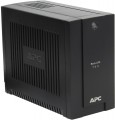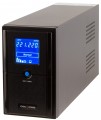Type
—
Standby. The simplest type of UPS, familiar to most ordinary users. Its main purpose is the ability to “softly” shut down work in case of power problems. When the voltage level is normal, the UPS supplies power to the load from the mains, and when the voltage drops or fails, it switches to its own battery. The resource of this battery is usually small — on the order of several minutes, which is usually enough only to save data. Also, such UPSs can smooth out short-term power surges, however, if such surges occur constantly, this wears out the battery and adversely affects the source itself. Redundant UPSs are widely used in home and office environments, they are usually of low power.
—
Smart. A kind of development of the idea of backup UPS; such sources not only provide power in case of a decrease or loss of voltage in the network — they also play the role of voltage stabilizers. The design of such UPSs includes a special regulator (usually in the form of a transformer) that compensates for changes in input voltage and supplies a stable voltage to the output. This allows you to supply constant voltage to the load without the use of batteries, making such blocks well suited for operation in networks with unstable voltage — they not only protect the load, but also do not wear out themselves. Interactive UPSs also mostly have low power and battery capacity and are used to protect individual devices.<
...br>
— Inverter (online). Another name is "double conversion". The most advanced type of UPS providing the highest degree of protection. The name comes from the inverter — an output voltage generator that directly supplies power to the load. The inverter itself simultaneously receives power from two sources — from the network and from a charged battery. In the event of a critical decrease or loss of voltage in the network, the inverter continues to supply energy, only from the battery. Such a scheme avoids voltage surges when switching from the mains to the battery (which is a serious drawback of the two types of UPS described above and can even damage the especially sensitive electronics connected to them). Inverter UPSs have the highest power (up to the ability to power an entire building) and can be designed for a three-phase connection (see "Input voltage"), and some models allow you to select batteries of different capacities, depending on specific needs. On the other hand, inverter UPSs are not very efficient, noisy and expensive, so they are mainly used when high power or advanced protection is critical.
— Low voltage. Miniature UPS for low-voltage electronics backup. Mini devices provide a low voltage DC output (typically 9V, 12V, 15V, or 18V). Traditional sockets are not provided for in their design, and you can usually connect one consumer to them. For example, when there is a power outage from a backup mini-UPS, a short-term autonomous power supply is established for the router (for up to one hour), security systems.Full load operating time
UPS continuous operation time from a fully charged battery when connected to a load with a power equal to the UPS output power (maximum or effective, depending on the type of load, see the relevant paragraphs for details). For a UPS designed to work with a home or office PC, a time of about 10-15 minutes is considered sufficient, this is enough to save data and complete work. To power servers, it is worth using devices with an operating time
of 20 minutes or more.
Half load operating time
UPS continuous operation time from a fully charged battery when connected to a load with a power equal to half the output power of the UPS (maximum or effective, depending on the type of load, see below for details). The operating time with such a load is much longer than for a full load, and even in the simplest models it can reach 20-30 minutes.
Input voltage range
In this case, the input voltage range is implied, in which the UPS is able to supply a stable voltage to the load only due to its own regulators, without switching to the battery. For redundant UPSs (see "Type") this range is quite small, approximately 190 to 260 V; for interactive and especially inverter ones, it is much wider. Some UPS models allow you to manually set the input voltage range.
Max. current
The maximum current drawn by the UPS. In fact, the current reaches its maximum value only when the UPS is operating from the mains with maximum load power and a completely discharged battery. However, when calculating the load on the power grid, this parameter should be taken into account.
Peak output power
The maximum output power supplied by the UPS, in other words, the highest apparent load power allowed for this model.
This indicator is measured in volt-amperes (the general meaning of this unit is the same as that of the watt, and different names are used to separate different types of power). The total power consumption of the load, implied in this case, is the sum of two powers — active and reactive. Active power is actually effective power (it is indicated in watts in the characteristics of electrical appliances). Reactive power is the power wasted by coils and capacitors in AC devices; with numerous coils and/or capacitors, this power can be a fairly significant part of the total energy consumption. Note that for simple tasks, you can use data on effective power (it is often given for UPS — see below); but for accurate electrical calculations it is worth using the full one.
The simplest selection rule for this indicator is: the maximum output power of the UPS in volt-amperes should be at least 1.7 times higher than the total load power in watts. There are also more detailed calculation formulas that take into account the characteristics of different types of load; they can be found in special sources. As for specific values, the most modest modern UPSs give out
700 – 1000 VA, or even
less — this is enough to power a PC of average performance; and in the most "heavyweight" models, th
...is figure can be 8 – 10 kVA and higher.Rated output power
The effective output power of the UPS is, in fact, the maximum active power of the load that can be connected to the device.
Active power is consumed directly for the operation of the device; it is expressed in watts. In addition to it, most AC devices also consume reactive power, which is "wasted" (relatively speaking) is spent by coils and capacitors. Apparent power (denoted in volt-amperes) is precisely the sum of active and reactive power; it is this characteristic that should be used in accurate electrical calculations. See "Maximum output power" for details; here we note that when selecting a UPS for a relatively simple application, it is quite possible to use only effective power. This is at least easier than converting the watts claimed in the characteristics of the connected devices into full power volt-amps.
The most modest modern "uninterruptibles" give out
less than 500 watts.
501 – 1000 W can be considered an average value,
1.1 – 2 kW is above average, and in the most powerful models this figure
exceeds 2 kW and can reach very impressive values (up to 1000 kW or more in some industrial class UPS).
Output voltage accuracy
This parameter characterizes the degree of difference between the AC voltage at the output of the UPS and the perfect voltage, the graph of which has the shape of a regular sinusoid. The perfect voltage is so named because it is the most uniform and creates the least unnecessary load on the connected devices. Thus, the distortion of the output voltage is one of the most important parameters that determine the quality of the power received by the load. A distortion level of 0% means that the UPS produces a perfect sine wave, up to 5% — slight sine wave distortion, up to 18% — strong distortion, from 18% to 40% — a trapezoidal signal, more than 40% — a square wave.
Efficiency
Efficiency (coefficient of performance) in the case of a UPS is the ratio of its output power to the power consumed from the network. This is one of the main parameters that determine the overall efficiency of the device: the higher the efficiency, the less energy the UPS wastes (due to heating parts, electromagnetic radiation, etc.). In modern models, the efficiency value can reach 99%.

